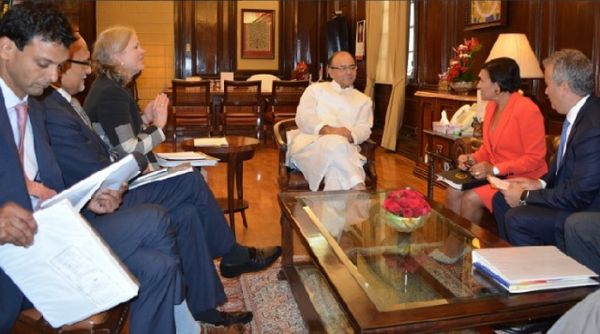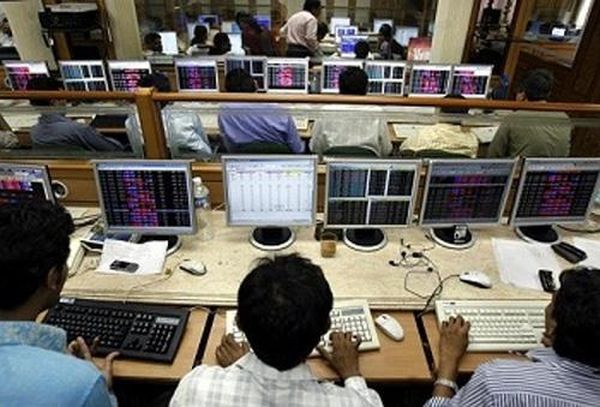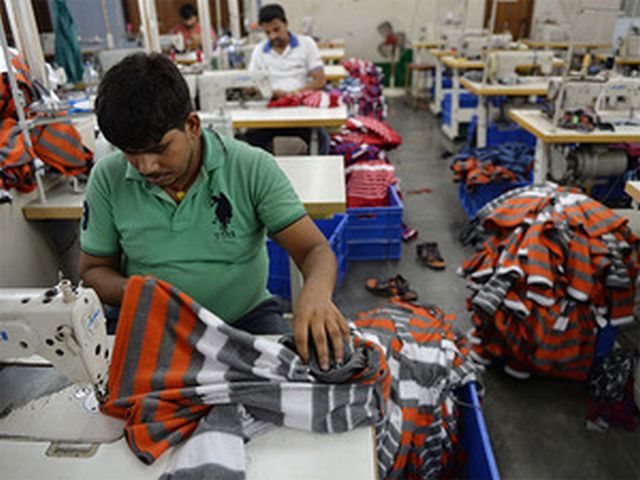
by admin | May 25, 2021 | Business, Corporate, Corporate Governance, Large Enterprise, News, Politics
 New Delhi : Finance Minister Arun Jaitley on Tuesday said that the number of trade registrations under GST has seen an increase of 30-35 per cent in the first three months, and that the total assessee base has already crossed one crore, which is an “encouraging” indicator.
New Delhi : Finance Minister Arun Jaitley on Tuesday said that the number of trade registrations under GST has seen an increase of 30-35 per cent in the first three months, and that the total assessee base has already crossed one crore, which is an “encouraging” indicator.
“Till now the trade registrations for Goods and Services Tax (GST) is very encouraging; 72 lakh traders have moved from the old system (previous indirect tax regime); 28 lakh people are new registrants. Total assesses have reached above one core,” Jaitley told reporters here at a press briefing.
“In the first three months, there has been a 30-35 per cent increase in registrations, which is a good indicator,” he said.
The Finance Minister added that currently the transition phase was on as the goods still being sold were manufactured during the earlier indirect tax regime.
“In initial months, the goods sold were manufactured in the old system. The transition phase is going on. The goods with new packaging will come into the system. We have reached about Rs 93,000-94,000 crore worth of monthly trading collections including IGST,” he said.
According to the September collection figures under GST, Rs 92,150 crore was collected from 42.91 lakh businesses up to October 23.
Over Rs 95,000 crore was collected through GST during July, the first month of its implementation, while the figure for August was over Rs 91,000 crore.
For August, only 55 per cent of businesses had filed returns till September 25.
Every month the businesses filing returns is seeing an increase, he added.
—IANS

by admin | May 25, 2021 | Banking, Commodity Market, Corporate, Corporate finance, Corporate Governance, Economy, Finance, Investing, Markets, News, Politics
 New Delhi : In a stimulus package aimed to boost flagging economic growth, create jobs and increase credit flow, the Union Cabinet on Tuesday approved a Rs 2.11 lakh crore recapitalisation plan for state-run banks and massive road infrastructure investment of nearly Rs 7 lakh crore over five years.
New Delhi : In a stimulus package aimed to boost flagging economic growth, create jobs and increase credit flow, the Union Cabinet on Tuesday approved a Rs 2.11 lakh crore recapitalisation plan for state-run banks and massive road infrastructure investment of nearly Rs 7 lakh crore over five years.
Indian industry warmly welcomed the steps.
Of the support to banks, Rs 1.35 lakh crore will be raised through recapitalisation bonds and the remaining sum through budgetary support and market borrowings, Financial Services Secretary Rajiv Kumar told the media in the presence of Finance Minister Arun Jaitley and a battery of Ministry Secretaries.
Under the road connectivity programme, the government will construct 84,000-km highways in five years. Of this, the Bharatmala project component will involve an outlay of Rs 5.35 lakh crore and generate 14.2 crore man-days of work.
Its funding will be raised as debt from the market (Rs 2.09 lakh crore), private investments through PPP (Rs 1.06 lakh crore) and from accruals to the central road fund and toll collections (Rs 2.19 lakh crore).
Jaitley said the economic blueprint to revive growth being presented follows extensive recent discussions on the state of the Indian economy.
“You will recall the press conference last time, where I mentioned we will respond appropriately to the situation as it develops,” he said.
“We have conducted an analysis within the Ministry and held detailed consultations with the Prime Minister on the state of the economy. We have decided on the steps needed to sustain the growth momentum,” the Finance Minister said.
“The unprecedented recapitalisation and the initiatives announced today (Tuesday) are expected to have a noticeable impact in the near term, contributing to accelerated economic activity, employment, and growth of the economy,” he added.
The public sector banks’ recapitalisation comes amid increase of their non-performing assets (NPAs), or bad loans, to 82 per cent of their stressed assets, Kumar said.
“The NPAs of government banks have increased to Rs 4.55 lakh crore between 2015 and 2017,” he said.
“Of this, 12 cases, since referred to the NCLT (National Company Law Tribunal), account for Rs 1.75 lakh crore, or 25 per cent of all NPAs,” he added.
Pointing out that the accumulated NPA figures reflect the result of “aggressive lending” in the past, Jaitley said the government’s move to fund banks comes at a time when private sector investment has dwindled.
Chief Economic Advisor Arvind Subranmanian, who was also present at the briefing, clarified that the recapitalisation bonds would count as debt, while their exact nature would be made available in due course.
The government, however, denied that this support to banks would affect fiscal consolidation.
The Finance Minister said the banks would get Rs 18,000 crore under the Indradhanush plan.
Under the Indradhanush roadmap introduced in 2015, the government had announced infusion of Rs 70,000 crore in state-run banks over four years to meet their capital requirement in line with global banking risk norms known as Basel-III.
This stimulus package comes after data from various sources showed India’s GDP growth flagging under the twin impact of demonetisation and Goods and Services Tax.
Commenting on the development, State Bank of India Chairman Rajnish Kumar said in a statement: “This milestone announcement on recapitalising banks in one go is a bold and courageous move and the need of the hour.”
“It will generate balance in overall demand and supply by bringing more investments in sectors like infrastructure. These funds will also help in efficiently managing risk and credit capital related requirements of the banks.”
The Confederation of Indian Industry (CII) welcomed the move, saying it will kick-start the credit cycle and facilitate private investments.
“The Cabinet decision to address a vital issue is very timely and welcome. We are especially pleased with the announcement of recapitalisation bonds, which CII had recommended strongly, among other measures,” said Chandrajit Banerjee, Director General, CII.
Industry chamber Ficci said it hoped the Reserve Bank of India will also pro-actively seek to boost investment and consumer demand through an easing of the repo rate.
The decision to invest in PSU (public sector undertaking) bank recapitalisation should result in increased lending, especially to the MSME (micro small and medium enterprises) sector,” said Pankaj Patel, President, Ficci.
The day’s announcement of recapitalisation along with a booster dose of Rs 14 lakh crore expenditure will prove to be a mega turnaround point for the Indian economy which was tackling issues out of GST and demonetisation, said D.S. Rawat, Secretary General, Assocham.
“These measures would surely set the stage for revival of private sector investment,” he said.
—IANS

by admin | May 25, 2021 | Banking, Corporate, Corporate finance, Corporate Reports, Economy, Finance, Markets, News, Politics
 (Note Ban Series)
(Note Ban Series)
By Aparajita Gupta,
New Delhi : Almost a year down the line, is Prime Minister Narendra Modi’s dream of making India a cash-less or less-cash country becoming a reality?
Industry stakeholders feel that though the note-ban drive by the government gave the necessary impetus to citizens to start adopting online payment platforms, a lot needs to be done by both the government and the industry to make it a success.
The adoption rate of online platforms was high during the demonetisation period, but it plateaued out as soon as cash became available in the system.
When the the Modi government banned high denomination notes of Rs 500 and Rs 1,000 notes on November 8 last year, removing an overwhelming amount of cash from the economy, people had to willy-nilly fall back on plastic or online transactions.
“The fact that 86 per cent of the cash available in the system was sucked out overnight gave an immediate boost to online/mobile payment platforms. There was a push-up factor,” Vishwas Patel, co-chair, Payments Council of India (PCI) and founder and CEO of CC Avenues, told IANS.
But once cash was back in circulation, those who earlier dealt mostly in cash went back to doing so, he said.
The PCI was formed under the aegis of Internet and Mobile Association of India in 2013 to cater to the needs of the digital payment industry.
He said during November, December 2016 and January 2017, online transactions were at their peak. In October 2016, debit card transactions stood at Rs 21,941 crore and those of credit cards at Rs 29,942 crore. Post-demonetisation, in December 2016, debit card transactions jumped to Rs 58,000 crore and those of credit card were at Rs 31,150 crore.
However, in August 2017, 10 months after the note ban, debit and credit card transaction stood at Rs 36,000 crore each, having come down substantially from the heights they achieved, but not falling back to the pre-demonetisation lows.
Patel said that after the cash flow in the system eased, small kirana shops stopped transacting through online payment channels, primarily because they did not want to take a tax number or a Goods and Services Tax number. “They do not have the wherewithal to pay taxes,” he said, adding that the “government needs to incentivise merchants, otherwise small and medium enterprises are going to go back to cash mode.”
Patel said security and trust in payment systems was something all stakeholders need to work on together. “As an industry body, we are preparing a National Negative Database of consumers and merchants so that we can reduce fraud and build trust in the eyes of consumers,” he added.
The database details would be circulated amongst payment gateway service providers, banks and card companies. “We are also working on a trust certificate that can be displayed by all merchants on their websites,” Patel added.
Vineet Singh, Chief Business Officer at Mobikwik, a payment app, said demonetisation had became a force multiplier. “It has pushed India a decade ahead towards the agenda of adopting online payment platforms. Naturally, things cooled down a bit post-demonetisation,” Singh told IANS.
Mobikwik had 3-3.5 crore users in the pre-demonetisation days and a year after note ban it has 6.5 crore. The company also witnessed a sharp rise in transactions from one million to three million within a year.
“Online payment companies in the last one year have increased their base significantly. They are experiencing healthy month-on-month growth and the adoption of online payment platforms was across all age groups,” Singh said, adding that “now everybody takes online payment seriously, which will provide a secular road towards a cash-less society.”
Vivek Belgavi, Leader, Fintech at PricewaterhouseCoopers, too said that, after cash returned to the system, people started transacting more in notes, but there was an uptick in digital transactions.
“Digital transactions have grown. But the key thing is that a lot of stepping stones for future adoption have been laid down — like the BHIM (Bharat Interface for Money) app by the government. Demonetisation was the shock that forced people to move to online channels,” he said.
Belgavi said the government should give more importance to low-cost infrastructure like availability of point-of-sales machines. “Industry should offer citizens the whole ecosystem of digital transactions. They should be offered an experience that is better than cash transactions,” he added.
Dewang Neralla, MD and CEO, Atom Technologies, told IANS their online payment processing volumes had grown three times since demonetisation.
“By March 2017, our transactions had doubled and with almost 11 months gone by we still see a healthy growth of around 20 per cent on a month-on-month basis. Today we process payments of about Rs 6,800 crore per month across more than 100,000 merchants. We expect this figure to grow at least three times in the next three years.”
Online transactions are bound to grow over a period of time, but in a country which overwhelmingly ran on cash, it may be difficult to do a quick digitisation.
(Aparajita Gupta can be contacted at aparajita.g@ians.in)
(Editors: The above article is part of a series of demonetisation stories leading up to November 8, the day note ban was imposed last year)
—IANS

by admin | May 25, 2021 | Banking, Economy, Markets, News
 Mumbai : Global cues, along with healthy buying in banking stocks and expectations of positive quarterly results, buoyed the key Indian equity indices during the mid-afternoon trade session on Tuesday.
Mumbai : Global cues, along with healthy buying in banking stocks and expectations of positive quarterly results, buoyed the key Indian equity indices during the mid-afternoon trade session on Tuesday.
According to market observers, healthy buying was witnessed in banking, oil and gas and metal stocks.
At 1.30 p.m., the 30-scrip Sensitive Index (Sensex), traded 80.60 points or 0.25 per cent higher.
The wider Nifty 50 of the National Stock Exchange (NSE) gained 23.15 points or 0.23 per cent at 10,208 points.
The Sensex of the BSE, which opened at 32,619.26 points, traded at 32,587.32 points (at 1.30 p.m.), higher by 80.60 points or 0.25 per cent from Monday’s close at 32,506.72 points.
The Sensex touched a high of 32,670.37 points and a low of 32,534.21 points during the intra-day trade so far.
“The BSE Sensex and the broader NSE’s Nifty 50 maintained their upward movement during the mid-afternoon session after the two key indices rose during the morning hours,” Dhruv Desai, Director and Chief Operating Officer of Tradebulls, told IANS.
—IANS

by admin | May 25, 2021 | Economy, Investing, Markets, News, Politics
 New Delhi : Post-demonetisation and implementation of the Goods and Services Tax (GST), the current economic slowdown has “bottomed out” and the recovery of the economy would “critically depend on the initiatives” the government takes from now onwards, according to a report released on Monday.
New Delhi : Post-demonetisation and implementation of the Goods and Services Tax (GST), the current economic slowdown has “bottomed out” and the recovery of the economy would “critically depend on the initiatives” the government takes from now onwards, according to a report released on Monday.
The report also said the quantum of impact of the structural reforms – demonetisation and GST – was expected but the quantum was not estimated and hence the current slowdown in the economy is painful.
“We believe that the slowdown has bottomed out, however, the stage and pace of recovery would critically depend on the initiatives that the government takes from now onwards to boost the growth momentum, especially the private sector investment, without which we will not be able to aim for an ambitious growth rate,” said Arun Singh, Lead Economist Dun & Bradstreet (D&B) India.
According to D&B Economy Observer, the rebound in industrial production, especially in capital goods is not just driven by festive-led demand and is on a sustainable basis.
“…as both the formal and informal segment of both the industrial and the services sector adjust themselves to the overall GST system and the frequent changes suggested under GST Councils, GVA (Gross value added) will grow only by 6.2 per cent in Q2 (second quarter) FY18, slightly higher than 5.6 per cent in Q1 (first quarter) FY18,” the report said.
It also said the recovery in exports, moderate interest rate, lower inflation rate, controlled trade deficit, sizable FDI inflows and the government’s commitment towards fiscal discipline are likely to pave the way for the economy to recover from the current scenario on a strong note.
“It is also expected that the continued reforms aimed at the formalisation and increase in accountability in the economy will help in preventing leakages and flow of resources in the desired direction and provide a strong foundation for a robust and sustainable growth process,” Singh said.
According to the report, Index of Industrial Production (IIP) is expected to grow by 4.-4.2 per cent during September 2017.
The CPI inflation would be in the range of 3.3-3.5 per cent and WPI inflation to be in the range of 2.7 – 2.9 per cent during October 2017, respectively.
—IANS

 New Delhi : Finance Minister Arun Jaitley on Tuesday said that the number of trade registrations under GST has seen an increase of 30-35 per cent in the first three months, and that the total assessee base has already crossed one crore, which is an “encouraging” indicator.
New Delhi : Finance Minister Arun Jaitley on Tuesday said that the number of trade registrations under GST has seen an increase of 30-35 per cent in the first three months, and that the total assessee base has already crossed one crore, which is an “encouraging” indicator.


